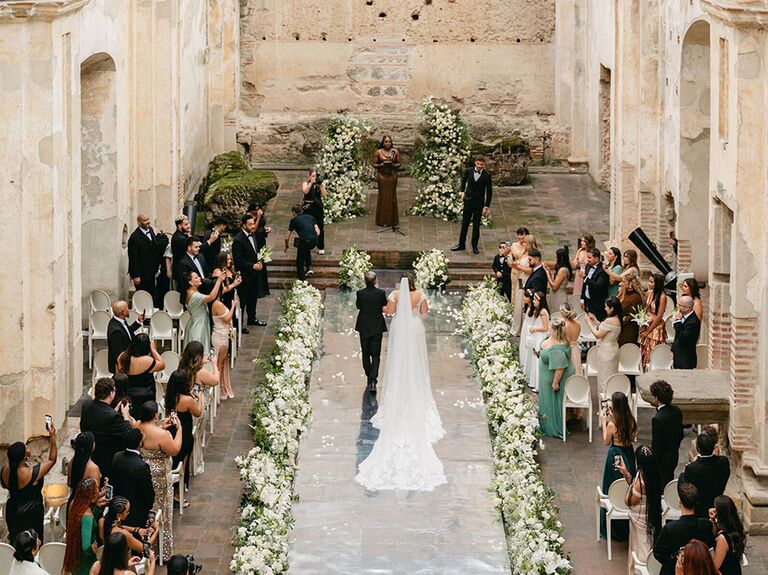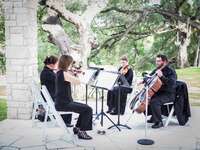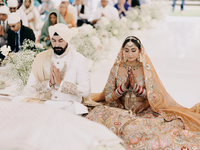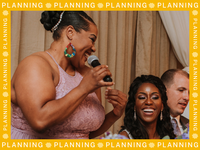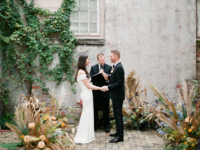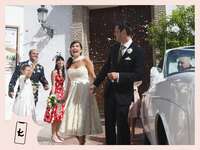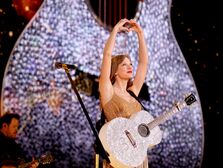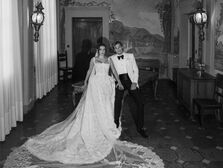A Comprehensive Guide to the Wedding Ceremony Processional Order
The processional is one of the most memorable moments of any wedding day. However, it's the wedding ceremony processional order that can get a little confusing. When does everyone make their entrance? Who walks down the aisle with whom? The answers to these questions really depend on your religion or cultural tradition. Your best bet is to work with your officiant to figure out the best ceremony entrance order for your big day. (If you haven't found this pro yet, head over to The Knot Vendor Marketplace.) But, at the end of the day, it's your wedding. So feel free to create your own processional order. We spoke to some of the top wedding planners and officiants to learn more about the most common wedding processional orders.
In this article: What Is a Wedding Processional? | How Long Is the Processional? | Printable Template
Wedding ceremony processional order: Modern | Catholic | Jewish | Christian | Nondenominational | Hindu | LGBTQIA+
What Is a Wedding Processional?
The wedding ceremony processional refers to the moment when you, your partner and your wedding party walk down the aisle in a specific order, initiating the ceremony. "At its core, processing is just a term for a group moving in an organized, and usually formal, fashion," says John Campbell, lead planner of John Campbell Events and Design and a pro selected for 2024 The Knot Ones to Watch. "Our usual idea of a wedding ceremony processional involves the family, wedding party and nearlyweds walking down the aisle in a preplanned or culturally prescribed way," Campbell adds.
While certain religious and cultural groups have traditional processional orders that are usually followed, you can adjust them to suit your own family situations and needs. "The most important thing to say about the wedding processional order is that there are no rules," says Cathleen O'Connell, cofounder and creative director of COJ Events for more than 20 years. "None of the religious traditions require a specific processional order. There are traditional ways of processing, but you have the choice of how you want your processional to progress," O'Connell continues. Wondering, "Do guests stand during the wedding processional?" Don't stress. You can go the conventional route and have the guests stand once the bride makes her entrance or you can go about that scenario however you please.
How Long Does the Processional Take?
The wedding ceremony processional order and timing are different for every couple. Yours will depend on your religious customs, the length of the aisle itself, which one of the wedding processional songs you choose and the number of people participating in the ceremony or walking down the aisle. According to Campbell, the average wedding processional will take no more than five minutes. But if it's a processional wedding for a Hindu couple the experience can be at least an hour long.
Printable Wedding Processional Order Template
Need a quick refresher on who walks down the aisle first during the ceremony? Bookmark our printable to-be-wed and wedding party processional order guide to have on hand for your rehearsal.
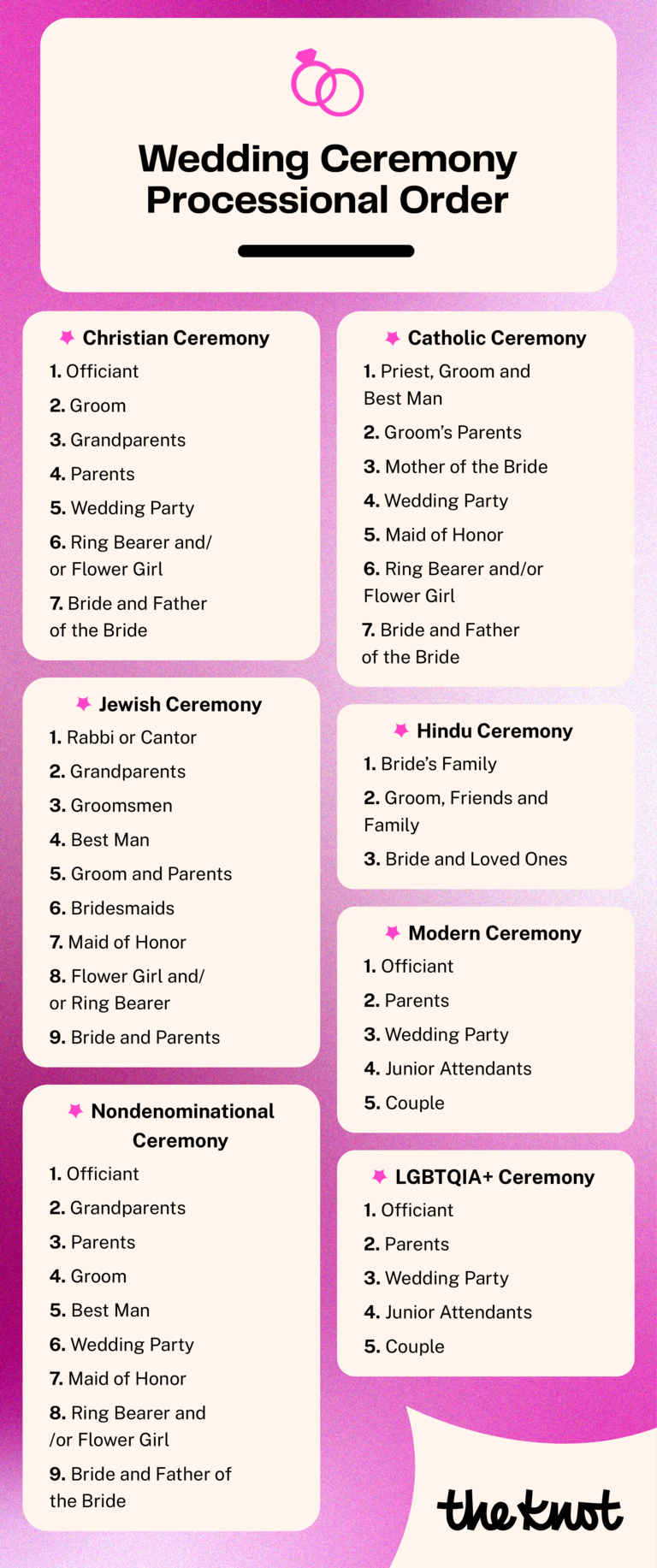
Modern Wedding Processional Order
After you've finalized the big decisions, like when the officiant reads your desired passages during the wedding ceremony order, you can focus on the finer details. This sample processional wedding order is a great starting point if you want a simple, modern wedding ceremony that's not tied to specific cultural or religious influences.
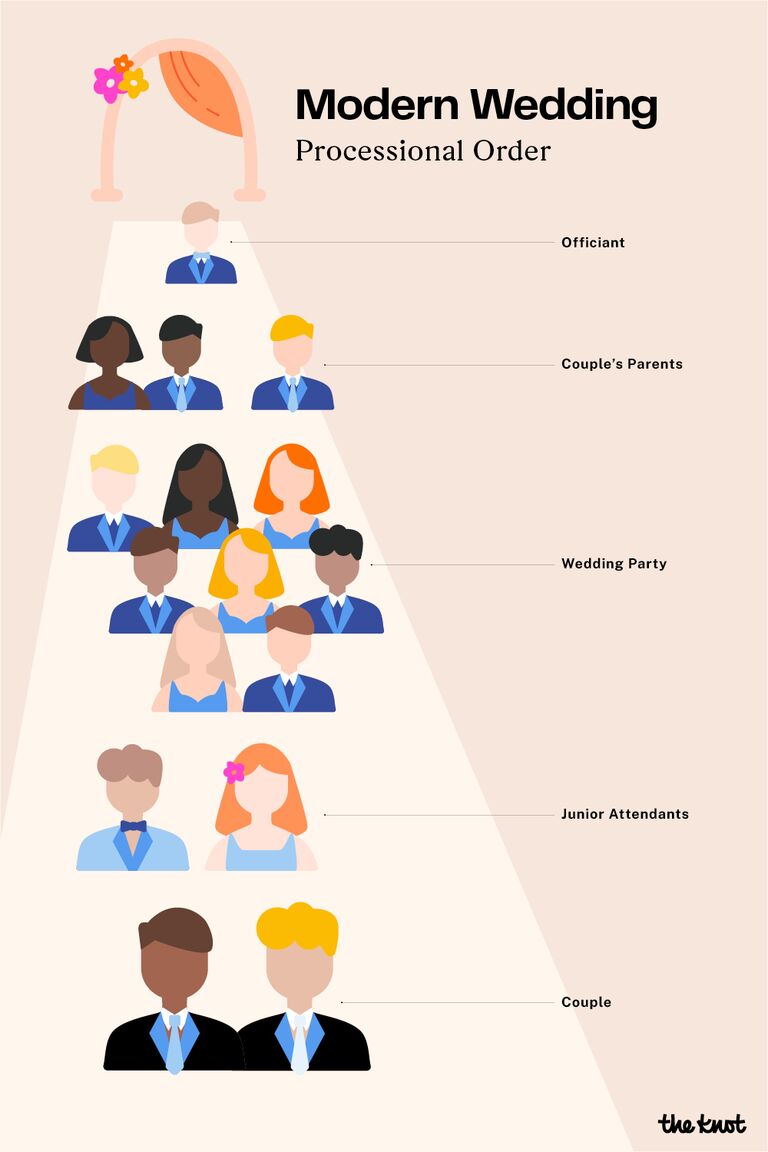
1. Officiant
Your officiant begins the ceremony by walking down the aisle and standing at the altar.
2. Parents
Next, your parents can walk down the aisle with each other or escorted by your siblings or step-parents (if applicable). One set of parents can go first, followed by the second set of parents.
3. Wedding Party
Depending on your preference, wedding party members can walk down the aisle one by one or in pairs. If your party includes bridesmaids and groomsmen, they should walk down the aisle in the order of where they'll stand at the altar, beginning with the outermost spot. The maid of honor and best man should be the final wedding party members to walk down the aisle.
4. Junior Attendants
If you have a ring bearer, flower girl or other attendant you've nominated (like flower guys or a dog bearer), they're next up in your wedding ceremony processional order.
5. Couple
To conclude your modern wedding lineup, you and/or your partner can walk down the aisle alone or escorted by parents (if they aren't already seated). As a final option, you and your partner can walk into the ceremony with each other.
Want suggestions for making your modern processional more personal and unique? Book one the best wedding officiants near you and talk to them about your vision.
Catholic Wedding Processional Order
There are several variations of a Catholic wedding processional, so it's a good idea to talk to your church about their traditional wedding entrance order. In the processional order below, the couple's parents walk down the aisle, but in some churches, the parents are escorted to their seats from the side as the processional begins.
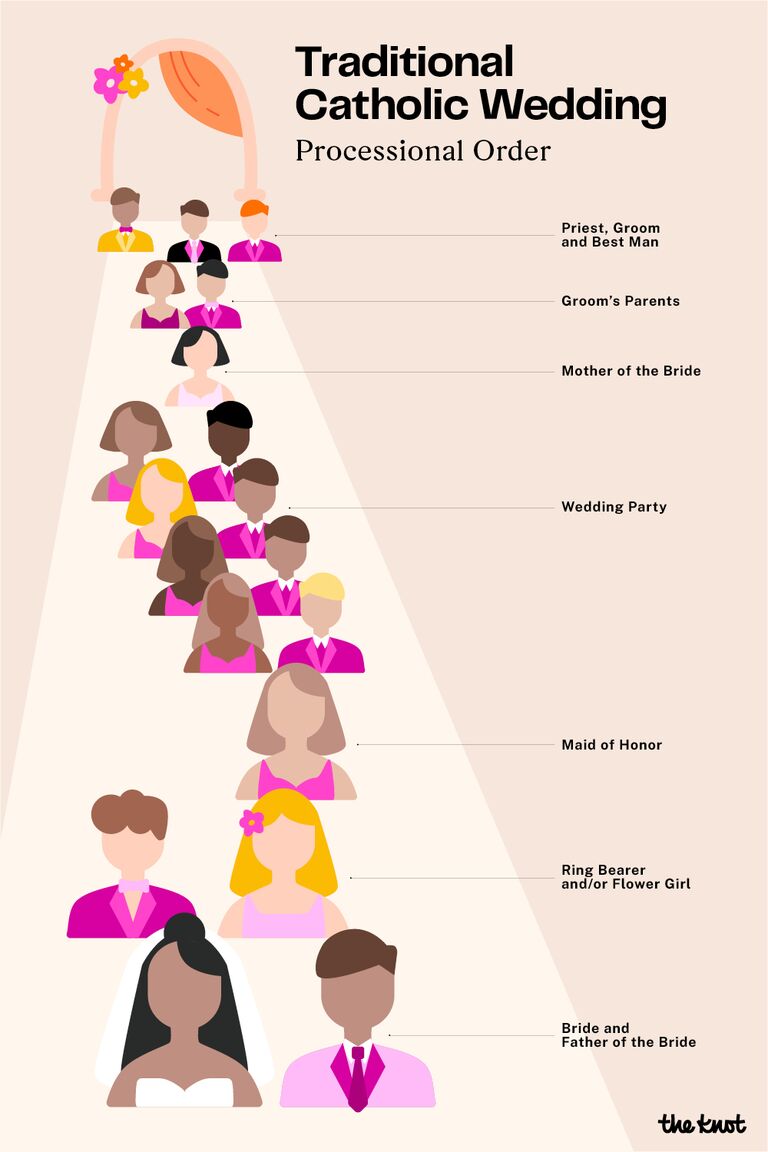
1. Priest, Groom and Best Man
The priest, groom and best man (in that order) will enter the church from a side door and take their places at the altar before the rest of the VIPs walk down the aisle. In some churches, all of the groomsmen will enter from the side as well.
2. Groom's Parents
The groom's parents will then walk down the aisle together, taking their seats on the right side of the ceremony venue.
3. Mother of the Bride
The mother of the bride may walk down the aisle solo, or be escorted by a family member. She will then sit in the front row on the left.
4. Wedding Party
The bridesmaids and the groomsmen will walk in pairs, with the bridesmaids on the left and the groomsmen on the right. At the end of the aisle, the pairs will split off and stand on their respective sides.
5. Maid of Honor
The maid of honor walks down the aisle last, and takes her place next to where the bride will be.
6. Ring Bearer and/or Flower Girl
When does the ring bearer walk down the aisle? Usually, the ring bearer and/or flower girl round out the wedding procession right before the bride enters. They make their way to either the wedding party at the altar or their family in the crowd.
7. Bride and Father of the Bride
Finally, the moment everyone has been waiting for. The bride, and a chosen escort, will march toward the altar. Traditionally, the father of the bride will walk her down the aisle, but it's entirely up to the bride who does this task.
FYI: Since you're planning a Catholic wedding, there are some things that are considered inappropriate for the religious ceremony, like the "Wedding March" song in some churches. Ensure check with your priest about your order and see if your Catholic wedding readings are fitting for the situation.
Jewish Wedding Processional Order
There are a few key differences between a Jewish wedding order of procession and other groups'. For example, the couple (not just the bride) are escorted down the aisle by both parents, who stand under the chuppah (wedding canopy) rather than sit with the rest of the guests. Another difference: In Jewish tradition, the women stand on the right and the men on the left.
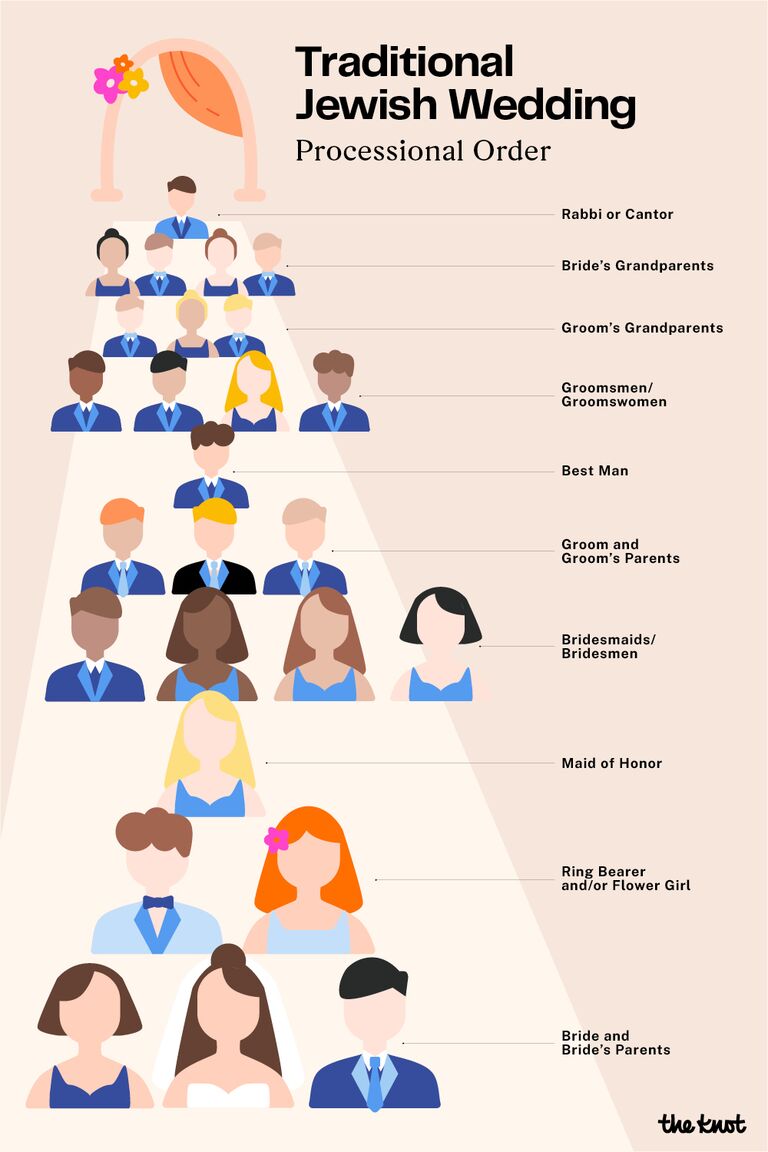
1. Rabbi or Cantor
The officiant (usually a rabbi or cantor) is generally the first person to walk toward the altar, signifying the ceremony is about to commence.
2. Grandparents
The grandparents of the couple will walk down the aisle next—first the bride's grandparents, then the groom's—taking their seats in the first row.
3. Groomsmen
Depending on how many groomsmen there are, they will either walk down the aisle individually or in pairs, taking their places on the left side of the chuppah.
4. Best Man
The best man is the last to walk down the aisle, and will stand the closest to the groom under or beside the chuppah during the ceremony.
5. Groom and Parents
In a Jewish ceremony, the groom is escorted down the aisle by his parents. They will then take their places under the chuppah on the left side.
6. Bridesmaids
The bridesmaids walk down the aisle next, solo or in pairs. They will stand on the right side of the chuppah.
7. Maid of Honor
The MOH is the last of the 'maids to walk down the aisle, and will position herself closest to the bride on the right side.
8. Flower Girl and/or Ring Bearer
The youngest attendants make their way down the aisle right before the bride. They may stand or sit, depending on their ages and preferences.
9. Bride and Parents
As the crowd stands, the bride, escorted by her parents, makes her way down the aisle. If the couple is participating in the traditional circling ceremony, the groom will meet her at the end of the aisle and either the bride will circle him seven times, or the couple will circle each other.
The above traditional wedding processional order isn't the only thing you need to know. Check out these other Jewish wedding traditions before you set your ceremony and reception timeline.
Christian Wedding Processional Order
When it comes to a Christian wedding ceremony entrance order, there are two options, says officiant Rev. Orsella Hughes, owner of Serenity Ceremonies by Rev. Orsella and affiliated with the International Association of Professional Wedding Officiants. The more traditional route is to have the officiant and groom enter from the side of the venue. A more modern approach is for both the officiant and groom to walk down the aisle with the rest of the VIPs. Here's a rundown of the Christian wedding processional order, according to Rev. Hughes:

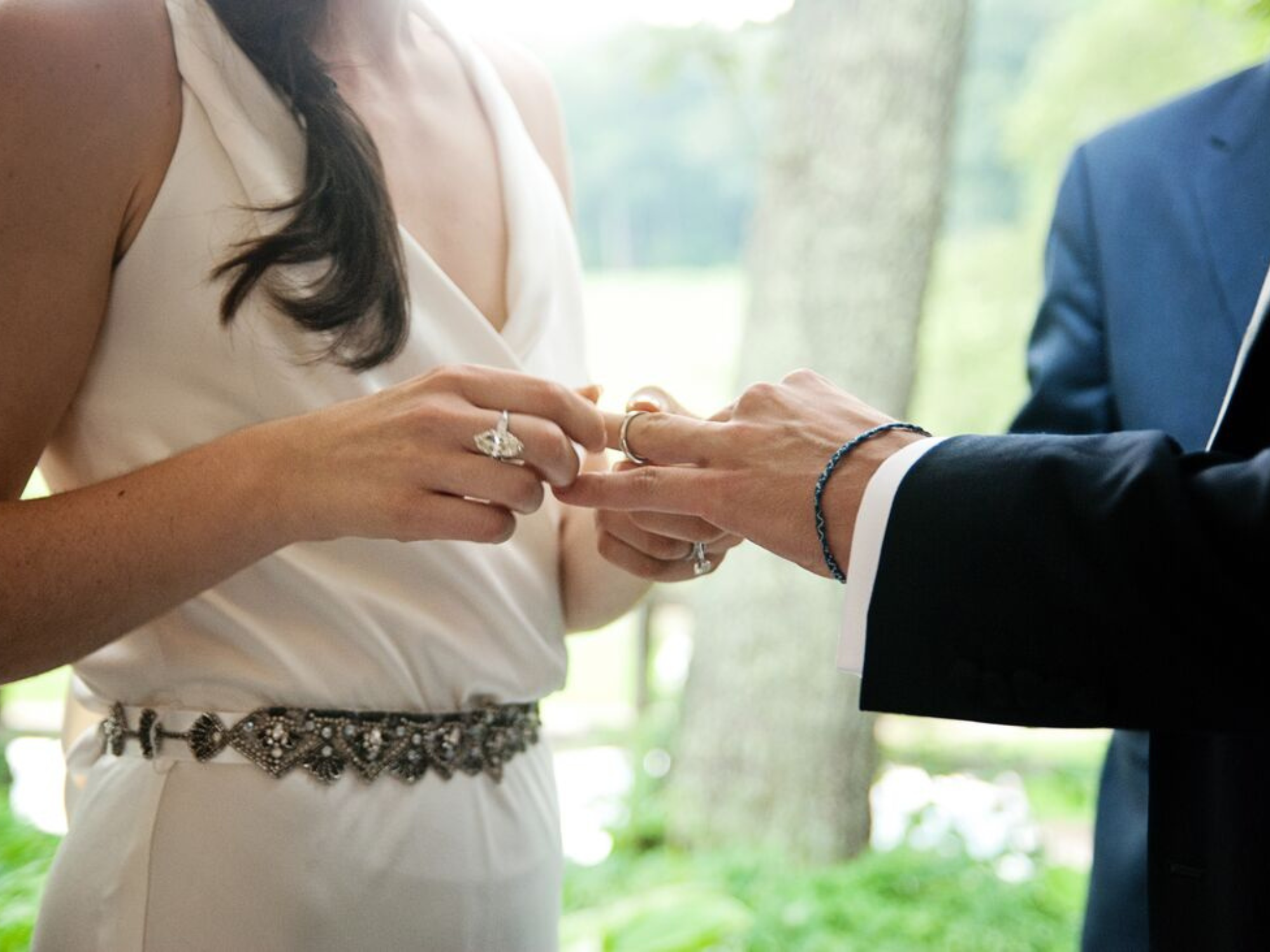

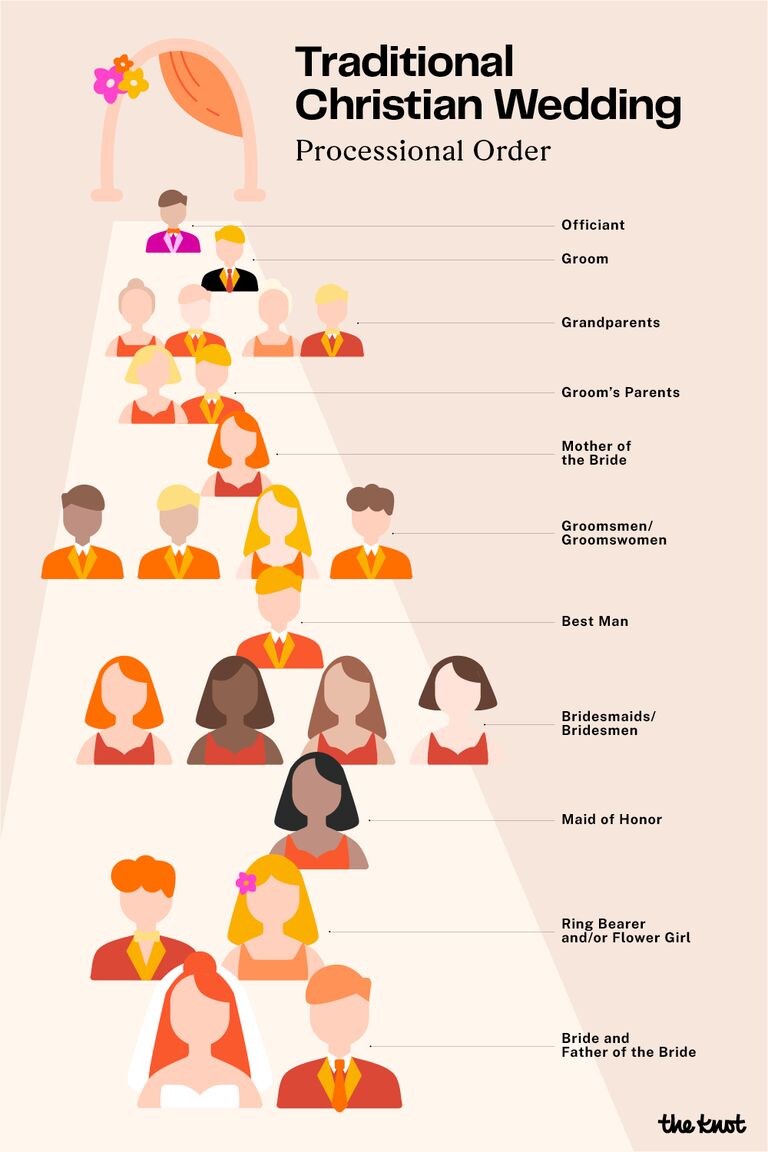
1. Officiant
If the officiant is walking down the aisle, rather than entering from the side, they're up first. "In addition to making announcements, the presence of the wedding officiant lets everyone know that the wedding is about to start," says Rev. Hughes.
2. Groom
The groom would then walk down the aisle. Sometimes he is followed directly by the groomsmen, and but more traditionally, the groomsmen would walk before or alongside the bridesmaids.
3. Grandparents
Typically the grandparents of the couple are next to walk down the aisle and find their seats in the front row.
4. Parents
Next up are the groom's parents, followed by the mother of the bride. "The bride's mother is traditionally escorted by another family member, like a son or brother," says Rev. Hughes. Stepparents and other parent-like figures may be included here, as well. Parents will sit in the front row, near the grandparents.
5. Wedding Party
When it comes to the wedding party processional order, there are a few options. The most classic processional order would have the bridesmaids and the groomsmen coming down the aisle in pairs. However, nowadays, the groomsmen can walk down the aisle individually either after the groom or after the parents (the best man is always last). Then, each bridesmaid would walk down the aisle solo, with the maid of honor at the end.
The first groomsman or bridesmaid to walk down the aisle will stand the farthest away from the couple, so the best man and maid of honor will stand directly next to the couple. Often this is organized by height—the tallest wedding party members would walk down the aisle first and stand the farthest away from the couple, etc.
6. Ring Bearer and/or Flower Girl
If young attendants will be participating in the ceremony, they are the last to walk down the aisle before the bride. Depending on their ages, they can either stand with the rest of the wedding party or take a seat with their family members.
7. Bride and Father of the Bride
"The bride and her escort (traditionally her father), is the last person to enter the ceremony space," says Rev. Hughes. "Once the bride is up front with the officiant and the groom, the wedding ceremony begins." The bride may also walk down the aisle with both parents, just her mom or another loved one, like a brother, grandparent, son or daughter, if preferred.
Don't forget there's a certain way to go about the wording during the ceremony. Here's the Christian wedding ceremony script to guide you.
Nondenominational Wedding Processional Order
Jacqueline Vizcaino, owner of Tinted Events Design and Planning with expertise in planning multicultural celebrations, says the nondenominational wedding processional order is perfect for couples who want to customize and personalize their wedding. "The possibilities are endless when creating a unique ceremony that speaks directly to your individual beliefs, values and personalities," Vizcaino adds. Generally, the wedding processional order for a nondenominational ceremony follows a similar pattern to a Christian processional order, but the couple may make substitutions and changes as desired. As with a Christian processional, the groom (along with the officiant and best man) may either enter from the side of the venue or, for a more modern approach, walk down the aisle.
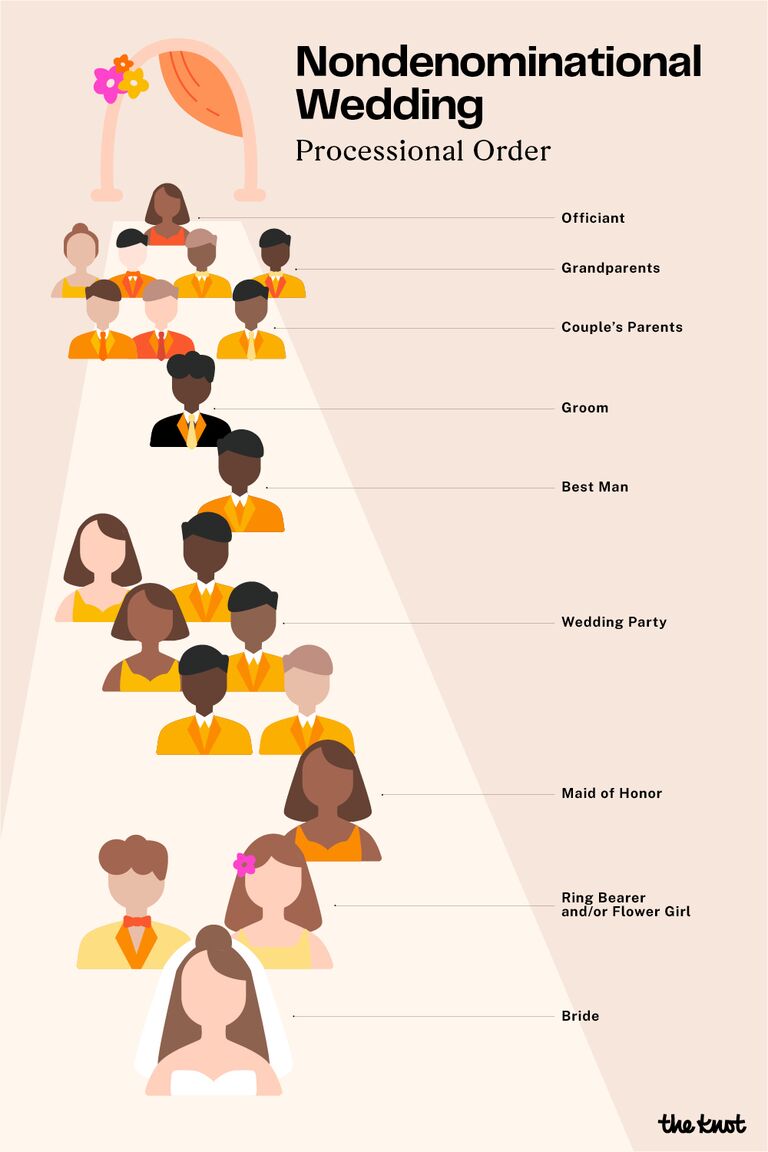
1. Officiant
The officiant may enter from the side of the venue, with the groom and best man, or walk down the aisle first.
2. Grandparents
It's up to the couple and their families whether or not the grandparents will join the processional, but if they do, they'll walk after the officiant.
3. Parents
Again, the couple's parents may or may not walk down the aisle (they can also just take their seats as the procession begins). Traditionally, the groom's parents will go first, followed by the mother of the bride, but the couple may choose to be escorted down the aisle by one or both of their parents.
4. Groom
If the groom is walking down the aisle, he may do so solo or escorted by one or both parents. In a nondenominational ceremony, the groom and his crew stand on the right side of the venue.
5. Best Man
The best man can either walk directly after the groom, or alongside the maid of honor after the rest of the wedding party members have entered.
6. Wedding Party
The wedding party members can walk down the aisle individually or in pairs. The person or people standing farthest away from the couple would enter first.
7. Maid of Honor
The MOH (and best man, potentially) is the last to enter before the young attendants. She will take her place next to the bride on the left.
8. Ring Bearer and/or Flower Girl
The little ones enter right before the bride, and either stand with the rest of the wedding party or sit with their parents or other close loved ones.
9. Bride and Father of the Bride
Last but certainly not least, the bride and her escort will make their way down the aisle. As mentioned, the bride is traditionally escorted by her father, but she may ask both parents, her father and stepfather or another loved one to take on this role.
For those wanting to stick to the unconventional route, there are more options for you. Try out these non-religious wedding ceremony scripts and nontraditional ways to walk down the aisle.
Hindu Wedding Processional Order
The order of the wedding processional for a Hindu wedding ceremony depends on a few factors, including the couple's family's traditions and the direction of their pandit or multicultural officiant. Some couples take a more Western approach to the processional, with both parents escorting the bride down the aisle. The processional ends once the bride arrives at the mandap, or altar.

1. Bride's Family
The bride's loved ones are typically the first to arrive at the ceremony so they can welcome the groom.
2. Groom, Friends and Family
"It is traditional for a Hindu wedding processional to begin with a baraat (groom's entrance), where the groom is accompanied by his family and friends on horseback, by elephant or in a special vehicle (usually a luxury convertible)," says Vizcaino. "This musical procession is accompanied by a DJ or a dhol (drummer). The energy is always high. The bride's family will welcome him at the entrance of the ceremony with great fanfare and music and a shower of rose petals and blessings."
3. Bride and Loved Ones
The kanya aagman, translated to "the girl's arrival," follows the groom's processional. The bride will often walk down the aisle underneath a canopy, escorted by loved ones such as her maternal aunt and uncle or sometimes her brothers. She then joins the groom at the mandap, and the ceremony begins.
The Hindu wedding ceremony processional order is full of life and flourishes. Look at these other unique wedding ceremony entrances for inspiration.
LGBTQIA+ Wedding Processional Order
Couples in the LGBTQIA+ community can take on any religious or cultural processional traditions and make them their own, or create a processional order based on their preferences and personal relationships.
"Queer couples have to decide what to make of the heteronormative traditions," says Maureen Cotton, spiritual wedding coach and officiant of The Soulful Wedding. Cotton, who has been ordained since 2015, notes that LGBTQIA+ couples have quite a few questions they'll need to answer: Does one of them prefer to enter first, as a groom often does, with the other entering last as the climax of the processional, like a bride often does? Or do they want to walk in together? Or do they walk in each one flanked by both of their parents? Below is an example of a wedding processional order where the couple would enter the ceremony together.
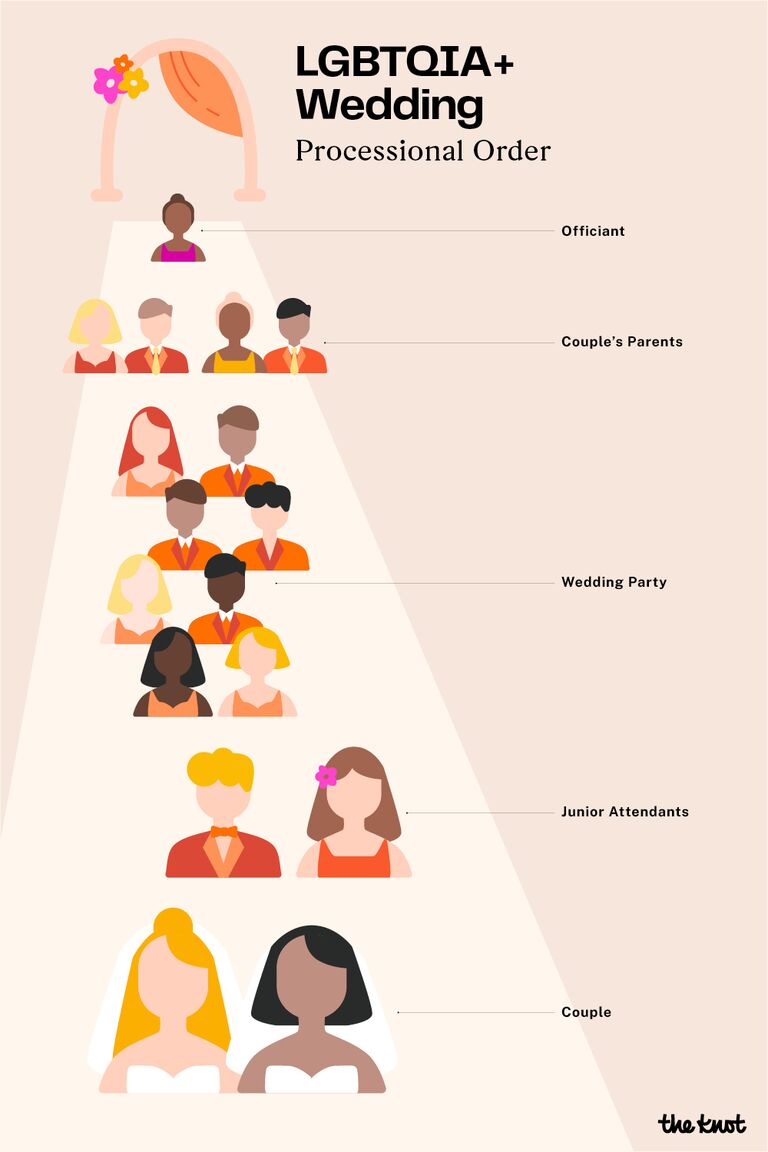
1. Officiant
The officiant kicks off the processional, and may either walk down the aisle or enter from the side of the venue.
2. Parents
If the couple is processing together, their parents would walk down the aisle after the officiant, one partner's parents first, followed by the other's.
3. Wedding Party
The wedding party members may walk down the aisle individually or in pairs. They take their places on either side of the altar, starting with the farthest away from the couple. The lead attendants (or best people) would walk last and stand closest to the couple at the altar.
4. Junior Attendants
If there are young attendants, they walk down the aisle directly before the couple. If they are comfortable, they can stand with the rest of the attendants, or sit with the rest of the guests.
5. Couple
As the guests stand, the couple enters together. The to-be-weds then stand at the altar as the ceremony begins.
The wedding processional order shouldn't be the only way you make your ceremony stand out. Pick your favorite of these LGBTQIA+ wedding readings and LGBTQIA+ wedding ceremony scripts for your affair.
